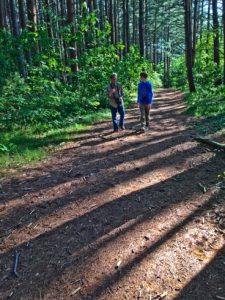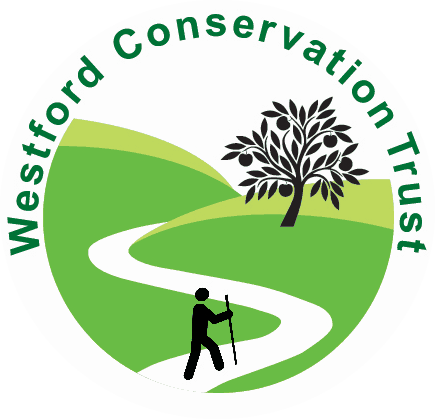
Many of us have taken down our birdfeeders this summer, due to the mystery bird disease that is affecting the east coast and mid-west. We are feeling a profound loss of the color and song in our yards. We miss “our” birds! What to do? Well, the birds are still around, but we need to put a bit more effort into seeing them. We can see and hear them by meeting them where they are: In the woods. Fortunately, Westford has many trails to explore, and birds can be heard and seen on all of them. When we walk in search of birds or wild plants, we need to walk with intention.
Intentional walking means slowing down and taking in everything around you; the sights, sounds and smells. It means feeling the wind on your face and the water on your fingers. It means being fully “in the moment”, not working on problems or chatting with others about unrelated matters.
Henry David Thoreau, in his wonderful essay, “Walking”, states: “Of course it is of no use to direct our steps to the woods, if they do not carry us thither. I am alarmed when it happens that I have walked a mile into the woods bodily, without getting there in spirit. In my afternoon walk I would fain forget all my morning occupations and my obligations to society. But it sometimes happens that I cannot easily shake off the village. The thought of some work will run in my head and I am not where my body is,–I am out of my senses. I would fain return to my senses. What business have I in the woods, if I am thinking of something out of the woods? ”
Just as Thoreau did, I prefer to walk alone, or with another person who is also walking with intention; a fellow birder, perhaps, or someone who wants to explore the plant life in the area. I carry a cell phone, and have confidence that there is nothing that can hurt me in the woods. Tucking the bottom of my slacks into my socks and spraying my legs below the knees with repellent, keeps the ticks away. I take binoculars and water bottle. My phone has the Sibley bird app on it, as well as iNaturalist for plant id. Alternately, tuck a field guide or two in your fanny pack. I like the Sibley bird guide and Peterson’s or Newcomb’s wildflower guide. For learning bird song, I like the CDs called Birding by Ear by Walton and Lawson. Walking in Nature is beneficial for body and mind. It elevates the feel-good chemical, dopamine, in our brains. Richard Louv coined the phrase “Nature Deficit Disorder”. He states, “Nature is not only nice to have, but it’s a have-to-have for physical health and cognitive functioning.” Bring your kids on the walk. They may resist at first, but before long, they’ll be exploring with enthusiasm.
Jim Robbins writes for the journal Yale Environment 360. His excellent article, published in January 2020, is titled, “Ecopsychology/How Immersion in Nature Benefits Your Health”. Robbins quotes Mathew White of the European Centre for Environment and Human Health, University of Exeter. White did a study of 20,000 people. He found that people who spent a total of two hours a week in green spaces, local parks or other natural environments, were substantially more likely to report good health and psychological well-being than those who didn’t. Robbins goes on to explain, “nature…is an antidote for stress: It can lower blood pressure and stress hormone levels, reduce nervous system arousal, enhance immune system function, increase self-esteem, reduce anxiety, and improve mood…..Attention Deficit Disorder and aggression lessen in natural environments”. Robbins points to Japanese researchers, who have studied the Japanese tradition of “forest bathing”(walking in the forest)… “[Researchers] suspect aerosols from the forests, inhaled during a walk, are behind elevated levels of Natural Killer or NK cells in the immune system, which fight tumors and infections”. Robbins concludes, “Some studies have found that anxiety over climate change is a growing phenomenon. Ironically, one of the best antidotes for that might be a dose of green space.”
Heading out either on a familiar trail or a new one, you are sure to find something new each time; a new plant blooming or a new bird flitting in the tree ahead. Trail maps can be downloaded from the Westford Conservation Trust website.
Many thanks to all flora and fauna reporters for the month of August. Please send me reports by September 26. You can e-mail me at mariancharman@gmail.com, write me at 7A Old Colony Drive, or call me at 978-692-3907
—————————————————————
**August 26, Just in today. Mass Audubon says it is now safe to put up our feeders again! See Mass Audubon’s updated recommendation here.
Late July Reports:
Rosemarie Koester, Providence Rd. July Report: many finches, goldfinch, house finch and purple finch. Two pairs of cardinals with young ones, blue jays, grackles, red-winged blackbirds, rose-breasted grosbeak pair, doves, chickadees, tufted titmouse, downy and red-bellied woodpeckers, cowbird seen once, hummingbirds at feeder and at bee balm and hosta plants. Yellow-shafted flicker, not seen before, eating on the ground. Deer in the back yard, a few gray squirrels, chipmunks rabbits, hawk being chased by birds, complaining very loudly, little dark gray frog, spiders, mosquitos, gnats. Busy bees are on the bee balm and at the tall plum poppy plant and hostas. “I watched a bee gather nectar from a plant of million bells. He went to the red blossoms but completely ignored the purple and peach blossoms”.
Marian/Bill Harman, Old Colony Dr. July 26, warm, humid, 80’s. The beautiful fragrance of sweet pepper bush is in the air. Air is very smoky from fires out west which came to Westford today.
August Reports:
Marian/Bill Harman, Old Colony Dr. August 1, 60’s, cool. A walk to the beaver dam. Lots of blueberries by the trail. I picked some. Lovely fragrance of sweet pepper bush which is blooming by the pond. A juvenile kingbird is calling repeatedly. Saw or heard, goldfinches, downy woodpecker, jays, pee-wee, catbird, cardinals, Carolina wren, tiger swallowtail butterfly. Some of the swamp maples are already turning red. August 18, 80’s partly cloudy. Hen turkey brought her six juvenile poults to the yard today, keeping them under cover under the shrubs all the time–a good Mom. Heard goldfinches, jays. August 19, 70’s, heavy rain (our part of hurricane Henri). Heard great-crested flycatcher, phoebe, white-breasted nuthatch, Carolina wren. August 23, 70’s, cloudy, humid. As we sat on the deck, a female hummingbird flew close over our heads. It was examining my red coffee mug, I think. Later she flew to the window on the deck, hovering and looking in. I think she needs the feeder to be able to tank up before migration. We will put it up tomorrow. She knows how to get what she wants! August 24, 80’s, sunny, humid. We put up the hummingbird feeder, and hummingbird came several times today. Jays and chickadees heard. August 25, 84 degrees, sunny and humid. “Our” hummingbird is coming to feeder repeatedly. Two spotted fawns came out at the edge of the back lawn, staying just barely in the woods and munching on leaves. They are beautiful twins.
Mike Killoran, Pine Ridge Rd. August 6, “The rabbits have young ones now. Second batch of phoebes has fledged. No cowbird this time around. One fledged just as we were walking out the door for a walk. Thinking we scared it, and seeing it not doing incredibly well on the ground I put it back in the nest. It flew back out as soon as I dropped it in so I guess it was ready. Nice view of a pileated woodpecker on a dying oak tree. Birds have been eating the ripe berries of a nearby tree. I’ve seen juvenile robins, adult robins, blue jays, and a first for me a gray catbird. It had so little markings I thought I wouldn’t be able to identify it but the brown under the tail was the key. Red tailed hawks have been around doing their signature screech which sends the chickens running for cover.”
Rosemarie Koester, August 8. Many juvenile gray tree frogs, seen at a neighbor’s house. They are about one half inch in size. [ Rosemarie sent a good photo].
[Juvenile gray tree frogs are green-MH]
Marian Harman is a member of the Westford Conservation Trust, a non-profit conservation organization whose mission is to protect Westford’s trails and open spaces. The Trust welcomes new members and volunteers. Visit us at westfordconservationtrust.org or find us on Facebook.
